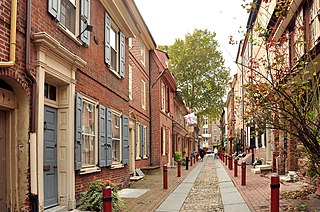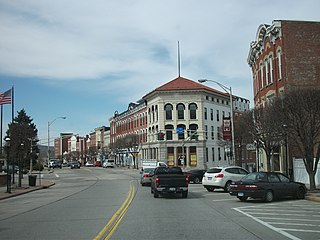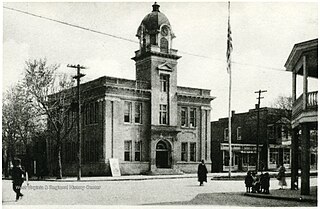
Historic districts in the United States are designated historic districts recognizing a group of buildings, archaeological resources, or other properties as historically or architecturally significant. Buildings, structures, objects, and sites within a historic district are normally divided into two categories, contributing and non-contributing. Districts vary greatly in size and composition: a historic district could comprise an entire neighborhood with hundreds of buildings, or a smaller area with just one or a few resources.

The Alabama Historical Commission is the historic preservation agency for the U.S. state of Alabama. The agency was created by an act of the state legislature in 1966 with a mission of safeguarding Alabama's historic buildings and sites. It consists of twenty members appointed by the state governor or who serve in an official position. The members represent a broad cross section of Alabamians including architects, historians, archaeologists, and representatives of state universities. The commission is tasked with acquisition and preservation of historic properties and education of the public about historic sites in Alabama.

Stone Street is a short street in the Financial District of Manhattan in New York City. It runs in two sections between Whitehall Street in the west and Hanover Square in the east. The street originally was one continuous roadway from Whitehall Street to Hanover Square, but the section between Broad Street and Coenties Alley was eliminated in 1980 to make way for the Goldman Sachs building at 85 Broad Street. The one-block-long western section between Whitehall and Broad Streets carries vehicular traffic, while the two-block-long eastern section between Coenties Alley and Hanover Square is a pedestrian zone.

This is a list of the National Register of Historic Places listings in Cleveland, Ohio.

This is a list of the National Register of Historic Places listings in Alameda County, California.

This is a list of the National Register of Historic Places listings in Daviess County, Kentucky.

This is a list of the National Register of Historic Places listings in Center Township, Marion County, Indiana.

The Hose Station No. 1 is a historic building located in downtown Davenport, Iowa, United States. It was listed on the National Register of Historic Places in 1983 and on the Davenport Register of Historic Properties in 1999. In 2019 it was included as a contributing property in the Davenport Motor Row and Industrial Historic District.

The Renwick Building is a historic building located in downtown Davenport, Iowa, United States. It has been listed on the National Register of Historic Places since 1983, and on the Davenport Register of Historic Properties since 2000. In 2020 it was included as a contributing property in the Davenport Downtown Commercial Historic District. It is known locally for the large painted sign on the north side of the building depicting the Bix 7 Road Race.

The Downtown Ossining Historic District is located at the central crossroads of Ossining, New York, United States, and the village's traditional business district known as the Crescent. Among its many late 19th- and early 20th-century commercial buildings are many of the village's major landmarks—three bank buildings, four churches, its village hall, former post office and high school. It was recognized as a historic district in 1989 and listed on the National Register of Historic Places, as one of the few downtowns in Westchester County with its social and historical development intact.

The Charles F. Ranzow and Sons Building is a historic building located on Lot 1, Block 18 of the original town of Davenport, Iowa, United States. It is contributing property in the West Third Street Historic District, which was added to the National Register of Historic Places in 1983. The building was individually listed on the Davenport Register of Historic Properties in 2000.

Woeber Carriage Works, also known as the G. Hager & Co. Carriage Works and the Davenport Plow Works, is a historic building located on Lot 3, Block 20 of the original town of Davenport, Iowa, United States. It was listed on the Davenport Register of Historic Properties on November 15, 2000. In 2020 it was included as a contributing property in the Davenport Downtown Commercial Historic District on the National Register of Historic Places.

Berkeley Springs station is a historic railway depot located at Berkeley Springs, Morgan County, West Virginia. The depot is a one-story, rectangular red brick building with a bell-cast, red tile roof and measures approximately 80 feet long by 20 feet wide. It features Mission Revival style details.

Morgan County Courthouse was a historic courthouse building located at Berkeley Springs, Morgan County, West Virginia. It was built in 1907 and was a two-story, three-bay, building constructed of yellow brick with limestone accents in the Neoclassical style. It featured a centered, octagonal clock tower that extended above the second story flat roof and dominated the main elevation. Also on the property were an annex and former jail (1939). The courthouse building was damaged by fire in 2006 and was subsequently demolished.

The Fayette County Courthouse Historic District is a historic district covering the downtown central business district of Fayette, Alabama. The majority of the buildings in the district were constructed soon after a fire destroyed the town in 1911; the architectural styles reflect common styles in commercial buildings around the Southern United States at the beginning of the 20th century. The district was listed on the National Register of Historic Places in 1976, and the boundaries of the district were increased in 2014.

The Downtown Cheyenne Historic District in Cheyenne, Wyoming is a historic district that was listed on the National Register of Historic Places in 1978. It is an area of about seven blocks, in the core of the original business district of Cheyenne, and home of many of the first masonry commercial buildings in Cheyenne.

The Okmulgee Downtown Historic District is the original downtown area of Okmulgee, Oklahoma, roughly bounded by 4th Street, 8th Street, Okmulgee Avenue, and the Frisco tracks. It was added to the National Register of Historic Places on December 17, 1992.

The Rapid City Historic Commercial District, sometimes called the Rapid City Downtown Historic District, is a 21-acre (8.5 ha), multi-block historic district in downtown Rapid City, South Dakota, United States. It includes 47 commercial buildings dating from the late 19th to early 20th centuries that formed the core of Rapid City's early economy. It was first listed on the National Register of Historic Places in 1974 and then expanded to its current size in 1998.

The YWCA Building, now the Envision Academy of Arts & Technology and Common Webster, is a historic Young Women's Christian Association building in Oakland, California designed by early female architect Julia Morgan. It was completed in 1915, became an Oakland Designated Landmark in 1977, and added to the National Register of Historic Places in 1984.























